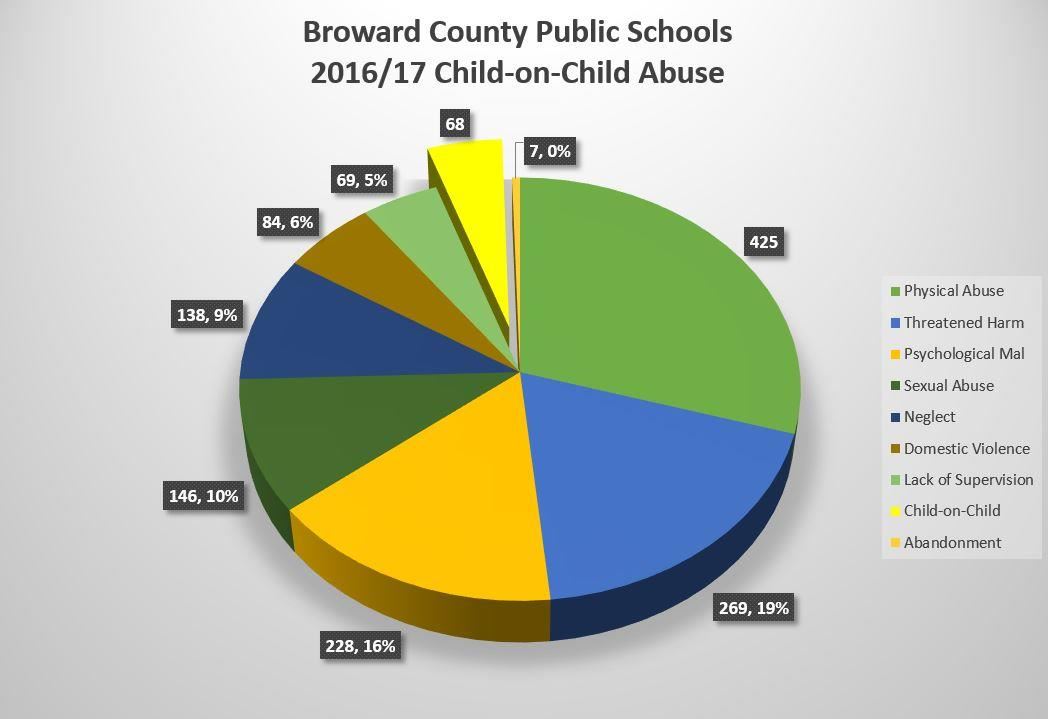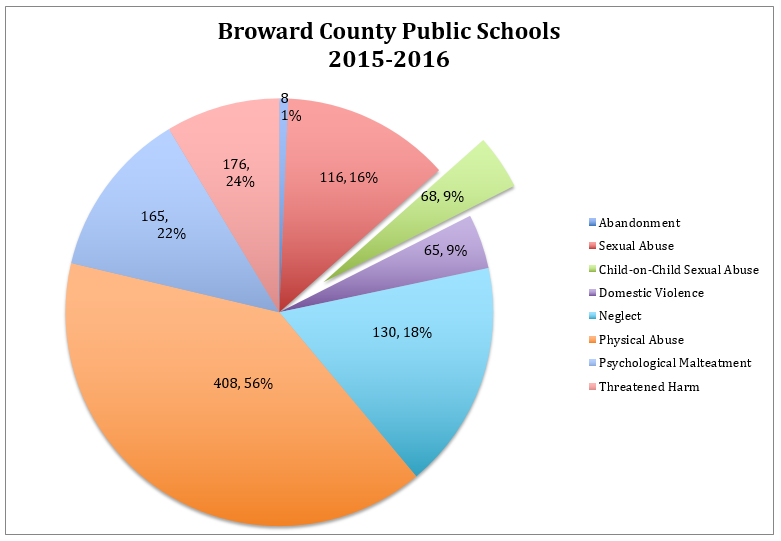- Home
- BCPS Departments
- Student Services
- Child Abuse & Neglect Prevention Services
- Training Directions
- Child on Child Sexual Abuse
Child on Child Sexual Abuse

Child on Child Sexual Abuse
-
Definition
In recent years, the school district, child protection agencies, and the state have become aware of an increasing incidence of children who engage in sexual behaviors with other children. A student who initiates sexual behavior with other children may be considered a juvenile sexual offender or a child with inappropriate sexual behavior, depending on the circumstances. Some children, especially young children, who engage in sexual behaviors are repeating learned behaviors from past sexual abuse.
Florida Statute 39 states that reports involving a known or suspected juvenile sexual offender or a child who has exhibited inappropriate sexual behavior shall be made and received by the Department of Children and Families through the Florida abuse hotline:
- The department shall determine the age of the alleged offender if known.
- If the alleged offender is 12 years of age or younger, the central abuse hotline shall immediately electronically transfer the report or call to the county sheriff’s office. The department (Department of Children and Families or it’s contracted investigative agencies) shall conduct an assessment and assist the family in receiving appropriate services pursuant to FS 39.307, and send a written report of the allegation to the appropriate county sheriff’s office within 48 hours after the initial report is made to the central abuse hotline.
- If the alleged offender is 13 years of age or older, the central abuse hotline shall immediately electronically transfer the report or call to the appropriate county sheriff’s office and send a written report to the appropriate county sheriff’s office within 48 hours after the initial report to the central abuse hotline.
Florida Statute 39 states that an “alleged juvenile sexual offender” means:
- A child 12 years of age or younger who is alleged to have committed a violation of chapter 794, chapter 796, chapter 800, statute 827.071, or statute 847.0133 (these are all criminal statutes); or
- A child who is alleged to have committed any violation of law or delinquent act involving juvenile sexual abuse. “Juvenile sexual abuse” means any sexual behavior that occurs without consent, without equality, or as a result of coercion. For the purposes of this paragraph, the following definitions apply:
- “Coercion” means the exploitation of authority or the use of bribes, threats of force, or intimidation to gain cooperation or compliance.
- “Equality” means two participants operating with the same level of power in a relationship, neither being controlled or coerced by the other.
- “Consent” means an agreement, including all of the following:
- Understanding what is proposed based on age, maturity, developmental level, functioning, and experience
- Knowledge of societal standards for what is being proposed
- Awareness of potential consequences and alternatives
- Assumption that agreement or disagreement will be accepted equally
- Voluntary decision
- Mental competence.
Florida Statute 39 states that a “child who has exhibited inappropriate sexual behavior” means a child who is 12 years of age or younger and who has been found by the department (Department of Children and Families or its community- based lead agencies such as ChildNet in Broward County) or the court to have committed an inappropriate sexual act.
-
Indicators
School staff may observe physical or behavioral indicators of physical abuse. Some indicators reflect suspected injuries on a child’s body; some reflect reports or verbal statements made by the child or others; some reflect behaviors. The indicators below are a compilation from case examples in Broward County, the Child Abuse Prevention Sourcebook for Florida School Personnel, the federal Child Welfare Information Gateway, and from Cynthia Crosson Tower: The Role of Educators in Preventing and Responding to Child Abuse and Neglect, 2003.
Physical Indicators
- Bruises, welts, lacerations, or abrasions that are not explained in a logical or plausible manner (Note the student’s affect and body language when the explanation is not plausible. You may ask: “Did someone hurt you?”)
- Bruises or welts reflecting the shape of the article used to inflict an injury (extension cord, belt or belt buckle, hair brush, etc.)
- Slap marks on cheeks or around ears; pinch marks on upper arms; lash marks on back, upper thighs, or buttocks
- Burns- Circular in shape with blisters and ulcers, possibly caused be a cigarette or match tip
- Burns- Dry contact burns with shapes suggestive of irons, heating coils, hair dryer elements
- Scalding or immersion burns from setting the student into hot liquid or pouring it over the skin
- Burns of unknown origin
- Repeated patterns of injuries, even when logical explanations are given.
Indicators in children with disabilities
- Chronic bruising under the arms of non-ambulatory children or disabled adult students
- Pain or swelling in shoulder or wrist area
- Bruising around or in the mouth of children or disabled adult students who are not able to feed themselves.
Clues That May Indicate Abuse
- Asks for help by telling a friend, teacher, or other school staff about abuse
- Shows extremes in behavior, including self-destructive acts, aggression, or withdrawal
- Is aggressive, oppositional, or defiant
- Cowers or demonstrates fear of adults
- Shows fearlessness or extreme risk taking
- Seems agitated or anxious when other children are crying
- Afraid to go home or comes to school too early
- Student is noticeable wary of adult contacts
- Is destructive to self or others
- Is described as “accident prone”
- Wears clothing that covers the body and may be inappropriate in warm weather (be aware that this may be a cultural issue as well)
- Is unable to form good peer relationships
- Cheats, steals, or lies (may be related to too high expectations at home)
- Is a low achiever (to learn, children must convert aggressive energy into learning; children in conflict may not be able to do so)
- Shows regressive or less mature behavior
- Is frequently absent from school with unsubstantiated illnesses.
School employees should consider the location of injuries on a child’s body. Soft tissue injuries on the face thighs, backs of the arms, or injuries on the back, are more likely to have been inflicted than injuries to the bony areas of the body (knees, elbows, forearms). Also consider the child’s demeanor when telling about the injury. Does a child who normally talks very directly and comfortably with you now seem anxious, unable or unwilling to look at you?
-
Data
As per State Statute, effective July 1, 2012, all child-on-child abuse cases must be reported to the hotline regardless of the age. For students 13 years of age or older with sexual behavior problems, law enforcement will investigate the behavior and acts as possible crimes. In the 2017-2018 school year, 4 percent of the reports made by Broward County Public Schools employees to the Florida abuse hotline involved child-on-child sexual abuse. The total number of students reported as being involved in child-on-child sexual behaviors was 68. Some of these reports concerned students who were suspected of having been sexually abused they or exploited through exposure to obscene materials, as evidenced by their initiation of sexualized behavior with other children or in the presence of other students. Other reports were of students who were directly victimized in what they perceived to be a sexual manner by other children.



Incidents of sexual abuse by children and adolescents are believed to be under-reported by school employees and by other groups as well. There is a lack of knowledge as to what is considered abusive as compared to normal, explorative development of sexuality. Additional training will be provided for school and area-based staff to improve understanding and promote consistent application of district procedures.
As stated in Florida Statute 39, juvenile sexual behavior ranges from non-contact sexual behavior such as making obscene phone calls, exhibitionism, voyeurism, and the showing or taking of lewd photographs to varying degrees of direct sexual contact, such as frottage, fondling, digital penetration, rape, fellatio, sodomy, and various other sexually aggressive acts.
Within Broward County Public Schools, we try to avoid labels that stigmatize the student. So we will usually refer to child as having sexually reactive behavior or a sexual behavior problem, instead of referring to the child as a juvenile sexual offender.
Examples of child-on-child sexual behaviors that have been exhibited at school include:
- A two year old child (in a child care program at a school) who was observed pulling down the diaper of another child and making face-to-genital contact
- A four year old boy (in aftercare at school) who went to the bathroom with another 4 year old boy and sucked his penis
- A four year old girl (in aftercare at school) who inserted her finger in the genitals of two other 4 year old girls
- Elementary age students who push down other children, get on top of them, and simulate the actions of intercourse
- Elementary age male students who intimidated and raped a female student
- Middle school students who cut class to engage in sexual behavior behind portable classrooms, in stairwells, etc.
- High school students who touched the breasts, buttocks, or genitals of other students.
It’s sometimes easy to assess that child-on-child sexual behavior meets the criterion of being without consent. For instance, very young children do not have the ability to engage in a sexually consenting relationship. By the time that children enter middle school, behaviors are more difficult to assess. The age of consent to engage in sexual behavior in Florida is 16 years. However, many middle school and high school students freely admit that they engage in sexual acts at earlier ages. School personnel may need assistance to determine whether sexual behavior meets the criteria listed in theDefinitions section for coercion, equality, and consent. Consultation may be sought with the child abuse designee or the school resource officer.
-
Resources
The child abuse designee at your school, by School Board policy, is the person with whom you should communicate regarding suspected child-on-child sexual abuse. Due to the complexity of the civil and criminal laws related to sexual abuse, another source of expertise is the school resource officer.
If an incident occurs at school involving sexual behavior, a school administrator should be informed, as well as consultation with the child abuse designee and school resource officer. This is important in order to address maintaining a safe school environment.
At the district level, contact Yva Dieudonne, program manager for Child Abuse Services, at (754) 321-2492. Child Abuse Services will assist the school if a safety plan is needed for a victimized student and/or for a sexually aggressive student. Questions regarding criminal law may be directed to the School Board’s law enforcement agency, the Special Investigative Unit (SIU) at (754) 321-0725. All incidents at school involving child-on-child sexual abuse must be reported to SIU by a school administrator.
The BSO Child Protective Investigations Section (CPIS) is also an important resource. The Florida abuse hotline will transmit reports to CPIS involving children who are under 13 years of age and the subjects of a child-on-child sexual abuse report. The child protective investigator will work with the students and their families, and will present each case to a Multi-Disciplinary Assessment Team (MAT). The MAT meets weekly, and makes recommendations for services, including counseling and psychosexual evaluations if needed. The MAT is conducted by The Chrysalis Center, which has extensive experience in this area. Chrysalis may be reached at (954) 587-1008.
Victims of child-on-child sexual abuse may receive services from the Sexual Assault Treatment Center (SATC). Parents may contact SATC at (954) 765-4159. However, SATC does not provide services to perpetrators. Sex offender specific treatment is needed for perpetrators of child-on-child sexual abuse, and should be provided by therapists with specialized training and experience in this area.
-
TO REPORT CHILD ABUSE, CALL 1-800-96ABUSE


